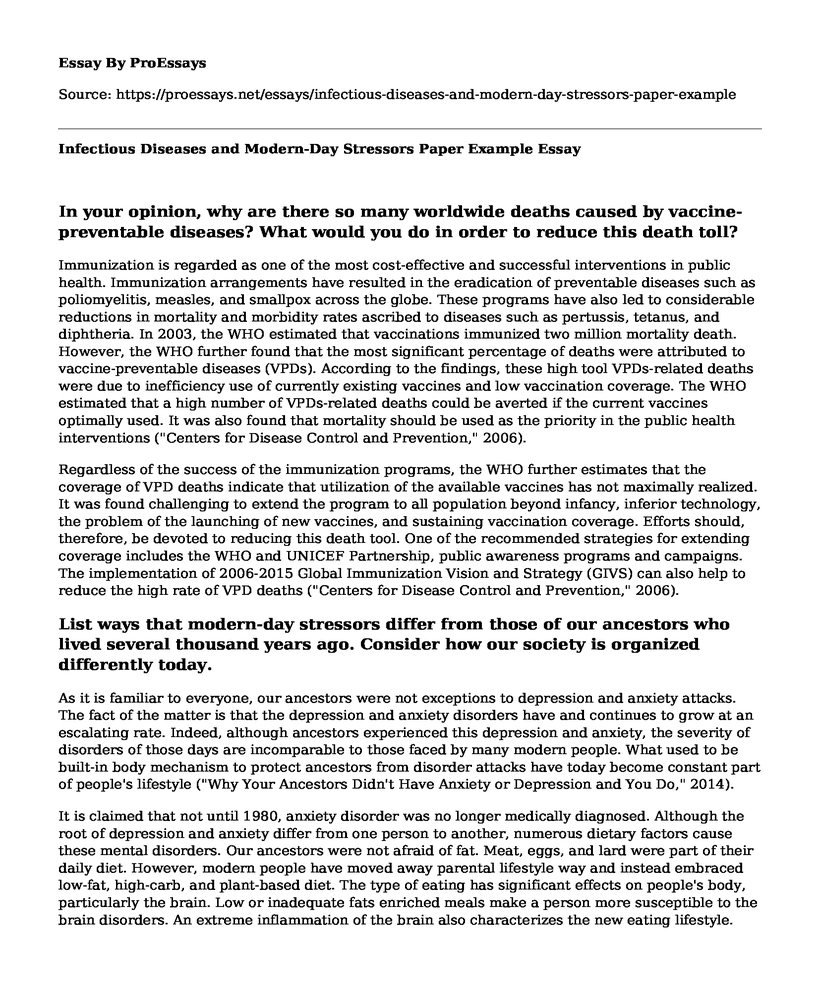In your opinion, why are there so many worldwide deaths caused by vaccine-preventable diseases? What would you do in order to reduce this death toll?
Immunization is regarded as one of the most cost-effective and successful interventions in public health. Immunization arrangements have resulted in the eradication of preventable diseases such as poliomyelitis, measles, and smallpox across the globe. These programs have also led to considerable reductions in mortality and morbidity rates ascribed to diseases such as pertussis, tetanus, and diphtheria. In 2003, the WHO estimated that vaccinations immunized two million mortality death. However, the WHO further found that the most significant percentage of deaths were attributed to vaccine-preventable diseases (VPDs). According to the findings, these high tool VPDs-related deaths were due to inefficiency use of currently existing vaccines and low vaccination coverage. The WHO estimated that a high number of VPDs-related deaths could be averted if the current vaccines optimally used. It was also found that mortality should be used as the priority in the public health interventions ("Centers for Disease Control and Prevention," 2006).
Regardless of the success of the immunization programs, the WHO further estimates that the coverage of VPD deaths indicate that utilization of the available vaccines has not maximally realized. It was found challenging to extend the program to all population beyond infancy, inferior technology, the problem of the launching of new vaccines, and sustaining vaccination coverage. Efforts should, therefore, be devoted to reducing this death tool. One of the recommended strategies for extending coverage includes the WHO and UNICEF Partnership, public awareness programs and campaigns. The implementation of 2006-2015 Global Immunization Vision and Strategy (GIVS) can also help to reduce the high rate of VPD deaths ("Centers for Disease Control and Prevention," 2006).
List ways that modern-day stressors differ from those of our ancestors who lived several thousand years ago. Consider how our society is organized differently today.
As it is familiar to everyone, our ancestors were not exceptions to depression and anxiety attacks. The fact of the matter is that the depression and anxiety disorders have and continues to grow at an escalating rate. Indeed, although ancestors experienced this depression and anxiety, the severity of disorders of those days are incomparable to those faced by many modern people. What used to be built-in body mechanism to protect ancestors from disorder attacks have today become constant part of people's lifestyle ("Why Your Ancestors Didn't Have Anxiety or Depression and You Do," 2014).
It is claimed that not until 1980, anxiety disorder was no longer medically diagnosed. Although the root of depression and anxiety differ from one person to another, numerous dietary factors cause these mental disorders. Our ancestors were not afraid of fat. Meat, eggs, and lard were part of their daily diet. However, modern people have moved away parental lifestyle way and instead embraced low-fat, high-carb, and plant-based diet. The type of eating has significant effects on people's body, particularly the brain. Low or inadequate fats enriched meals make a person more susceptible to the brain disorders. An extreme inflammation of the brain also characterizes the new eating lifestyle. Many of the modern people have switched from the consumption of pastured butter, coconut oil, and other beneficial fats. The ultimate consequences of the changes in diet are the inflammatory cytokines which are attributed to anxiety and depression ("Why Your Ancestors Didn't Have Anxiety or Depression and You Do," 2014).
Most anxiety and depression disorders in the modern life are also attributed to the tendency of people themselves to unrealistic personal goals. When their effort to accomplish these goals is unmet or when they are not able to pursue all of them at once, they end up being stressed. Therefore, most of these stresses are the ultimate result of the mismatch between people's desires and their achievements (Jackson, n.d.).
References
Centers for Disease Control and Prevention (CDC. (2006). Vaccine preventable deaths and the Global Immunization Vision and Strategy, 2006-2015. MMWR. Morbidity and mortality weekly report, 55(18), 511.
Jackson, K. The Evolution of Stress, Retrieved from: https://www.paleoplan.com/2015/02-12/evolution-stress/Why Your Ancestors Didn't Have Anxiety or Depression and You Do. (2014). retrieved from: https://ancestral-nutrition.com/why-your-ancestors-didnt-have-anxiety-or-depression-and-you-do/
Cite this page
Infectious Diseases and Modern-Day Stressors Paper Example. (2022, Jul 03). Retrieved from https://proessays.net/essays/infectious-diseases-and-modern-day-stressors-paper-example
If you are the original author of this essay and no longer wish to have it published on the ProEssays website, please click below to request its removal:
- Problems of the American Health Care System
- Research Paper on Health Information Management
- How Technology Is Driving the Health Care Industry Essay
- Nutrition Analysis Paper Example
- Case Study: Rheumatoid Arthritis
- Essay Example on School-Age Child Care: Quality Matters for Kids' Growth
- Essay Example on Nurses' Shift Work: Medication Safety & Patient Care







